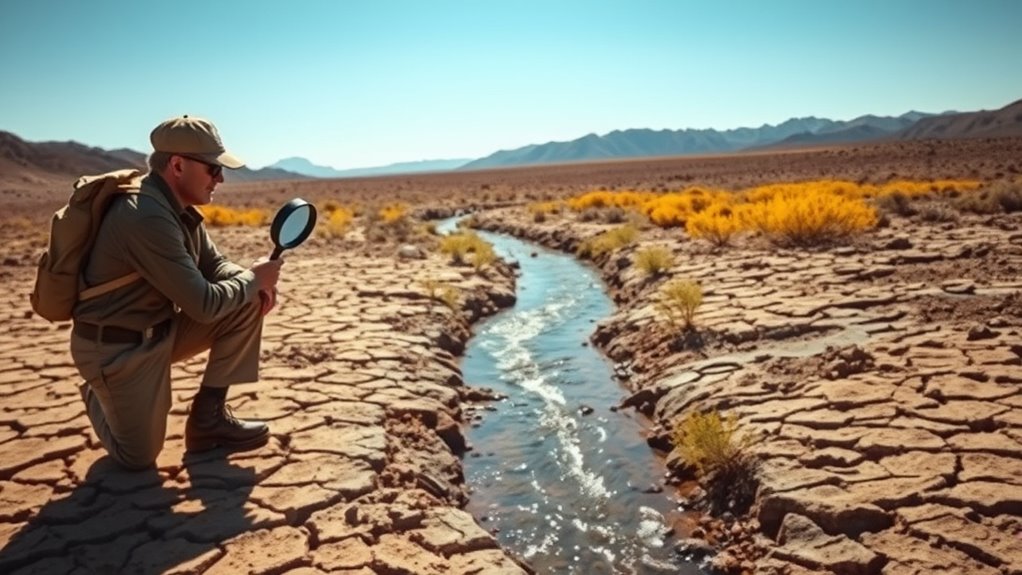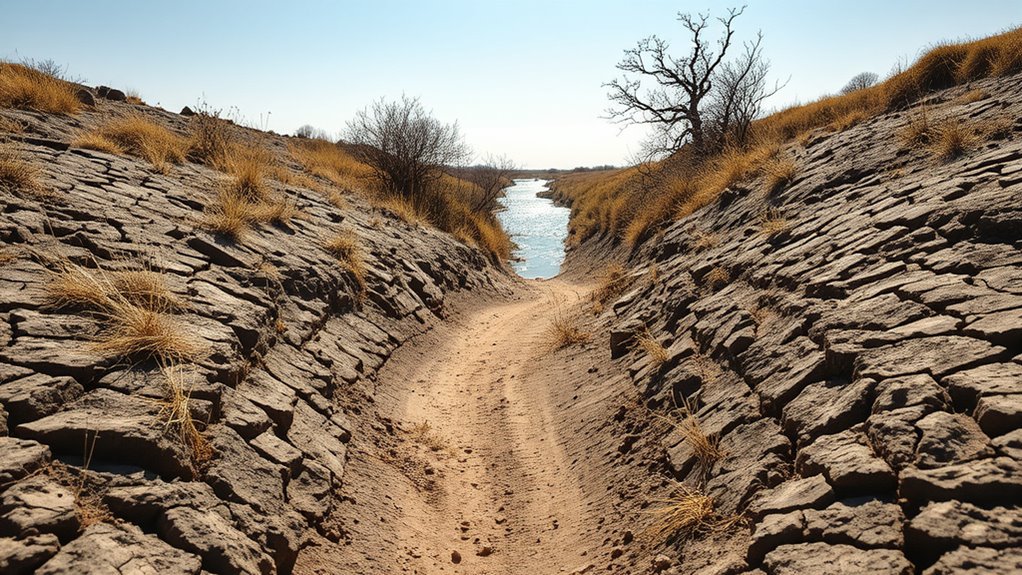In drought conditions, you should use environmental clues like lush vegetation, mossy stones, damp soil, and low-lying areas to locate safe water sources. Observe landscape features such as valleys and slopes, and talk to locals for insights on reliable streams. Set up rainwater collection systems and test water quality before use. If you keep exploring, you’ll discover more effective methods to find and guarantee safe water sources during dry spells.
Key Takeaways
- Identify landscape features like low-lying areas, valleys, and slopes that may harbor residual or underground water sources.
- Observe environmental indicators such as lush vegetation, mossy stones, and damp soil to locate potential streams.
- Consult local residents, farmers, and authorities for insights on water availability and recent stream activity.
- Use simple water testing kits to assess stream water safety, checking for bacteria, chemicals, and contamination signs.
- Collect rainwater through barrels or catchment systems as an alternative source when natural streams are scarce or unsafe.

Ever wonder how experts track down hidden water sources? It’s a skill that combines knowledge, observation, and strategic planning—especially when drought conditions threaten your ability to find reliable water. When traditional sources dry up or become contaminated, you need to get creative. Rainwater harvesting becomes an essential tool, allowing you to collect and store rain before it’s lost. By setting up simple systems like barrels or more advanced catchment setups, you can tap into a renewable resource that often goes unnoticed. This method not only provides a supplemental water supply but also reduces your reliance on groundwater, which is increasingly at risk of groundwater contamination. Groundwater is a critical resource, but it’s vulnerable to pollution from pesticides, industrial waste, and septic systems. Knowing how to detect signs of contamination—like unusual tastes, odors, or discoloration—can save you from using unsafe water. When searching for a safe stream, you’ll want to avoid areas near agricultural runoff or industrial sites, as these are common sources of groundwater contamination.
To locate clean water sources, you need to read the landscape carefully. Look for natural indicators like lush vegetation or mossy stones, which often suggest the presence of underground water. During droughts, surface streams might shrink or disappear, so focusing on the terrain’s natural features is key. Low-lying areas, valleys, and slopes can guide you to subsurface water flows, especially if you notice damp soil or persistent green patches where plants thrive despite dry conditions. It’s also wise to consult local knowledge—farmers, longtime residents, or local authorities often have insights into where water is still accessible. Understanding projector technology can also help you assess light and environment conditions, which is useful when planning water collection setups in different settings.
In addition to visual cues, you can employ simple testing methods to assess water quality. Using water test kits, you can quickly check for contaminants, bacteria, or chemical pollutants. When you find a possible water source, always consider the potential for groundwater contamination. Even if the water looks clear, it might harbor unseen toxins. Boiling or filtering water from uncertain sources helps mitigate health risks. In drought conditions, your goal is to identify water that’s both accessible and safe, while minimizing reliance on compromised groundwater. By combining observation, water harvesting techniques, and proper testing, you can effectively locate and utilize safe streams or alternative water sources, ensuring you stay hydrated and healthy even when water becomes scarce.
Frequently Asked Questions
How Can I Test Water Safety at a Stream?
To test water safety at a stream, you should start with water quality testing using a portable kit or lab analysis to check for contaminants like bacteria, nitrates, and pH levels. Look for stream safety indicators such as clear water, absence of foul odors, and minimal algae or debris. Always guarantee you follow testing instructions carefully, and if in doubt, avoid drinking the water until lab results confirm it’s safe.
What Tools Are Essential for Locating Reliable Water Sources?
To locate reliable water sources, you need essential tools like a GPS device for stream mapping and a water testing kit to assess water quality. Use the GPS to identify potential streams and map their flow, while testing kits help determine safety. Carry a compass for navigation, and a notebook to record observations. These tools guarantee you find streams that are both accessible and safe for use.
Are There Legal Restrictions on Collecting Water From Streams?
When collecting water from streams, you need to consider legal considerations and water rights. Laws vary by location, so you should check local regulations before collecting water. Some areas may restrict water use or require permits to protect resources. Ignoring water rights can lead to fines or legal trouble. Always research your area’s rules, respect property boundaries, and ensure you’re collecting water legally to avoid issues.
How Do Seasonal Changes Affect Stream Water Availability?
Seasonal changes markedly impact stream water availability. During spring, seasonal runoff from melting snow and rain increases water flow, making streams more accessible. In contrast, summer and fall often see reduced flow due to drought impact, leading to lower water levels and potential water shortages. You need to monitor these seasonal fluctuations carefully, especially during droughts, to identify streams that still offer safe, reliable water sources despite changing conditions.
Can Wildlife Presence Indicate Safe Drinking Water?
Wildlife indicators, like animal tracks and frequent visits, can hint at safe drinking water sources. If you notice animal tracks leading to a stream, it suggests the water is accessible and possibly clean enough for wildlife to rely on. However, always verify water quality before drinking, as animals may drink from contaminated sources. Using wildlife indicators can guide you, but don’t forget to test and treat water for safety.
Conclusion
Remember, water is life’s most precious resource—don’t take it for granted. By learning how to identify safe streams during droughts, you become a true water-source sleuth, ensuring you and your community stay hydrated. Trust your instincts, stay vigilant, and keep searching. As the saying goes, “A little caution goes a long way.” Stay prepared, stay safe, and always respect the water you find. Your efforts can make all the difference.










